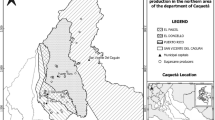Abstract
This paper presents an example of how agroforestry is practised to satisfy the local people's basic subsistence needs in the isolated Indian Ocean island of Soqotra, Republic of Yemen, south of the Arabian Peninsula. Combined with an arid tropical climate, the harsh seasonal conditions and annual period of isolation have moulded the culture of the Soqotra population, and fostered a traditional approach to land-use, based on the seasonal cultivation of homegardens and ranging of livestock (mostly goats). The homegardens contain many species of cultivated plants, composed of a wide diversity of plant groups. In addition to food, some cultivated plants provide medicine (mostly endemic plants such as Aloe perryi, Jatropha unicostata, Commiphora ornifolia), forage for domestic goats, cattle and camels (e.g., Paracalyx sp., Thespesia populnea, Pennisetum purpureum), shade and other aesthetic values (e.g., Cordia sinensis, Parkinsonia aculeata, Pithecolobium dulce). Most gardens are located around the periphery of towns and villages, with aspects of location, climate, and other ecological parameters carefully considered in their establishment. Homegardens are mostly worked by women, and to a lesser extent by children and men. At present, only a small proportion of Soqotra's population cultivates homegardens. Historically, and up to the present day, there has been little commercial utilisation of the cultivated species. Considerable potential exists for the development and / or expansion of local markets, although the recent increase in supply of produce from the mainland via commercial air delivery may limit such expansion.
Similar content being viewed by others
References
Al Sagheir O. and Porter R.F. 1996. The bird diversity of Soqotra. In: Proceedings of the First International Symposium on Soqotra Island: Present and Future. Vol. 1. United Nations Publications, New York, pp. 199-212.
Balasubramanian V. and Egli A. 1986. The role of agroforestry in the farming systems in Rwanda with special reference to the Bugesera-Gisaka-Migongo (BGM) region. Agroforestry Systems 4: 271-289.
Balfour I.B. 1888. Botany of Soqotra. Transactions of the Royal Society of Edinburgh 31, 446 pp.
Brown G.H.H. 1966. Social and Economic Conditions and Possible Development in Socotra. Report Royal Geographic Society.Royal Geographic Society.
Brownrigg 1985. Homegardening in International Development: What Liter Hamburg 76: 85-96.
Harrison P. 1987. The Greening of Africa: Breaking through in the Battle for Land and Food. Paladir/Earthscan, London.
Kotschi J. et al. 1989. Ecofarming in agricultural development. In: Deutsche Gesellschaft für Technische Zusammenarbeit (GTZ) (ed.), Tropical Agroecology. Vol. 2. GmbH-Technical Cooperation, Germany.
Ludwig H.D. 1967. Ukara-Ein Sonderfall Tropischer Bodennutzung im Raum des Viktoria-Secs. Institut für Wirtschaftsforschung. Afrika-Studien Nr. 22, Weltforum, München.
Mies B.A. and Beyhl F.E. 1996. The vegetation ecology of Soqotra. In: Proceedings of the First International Symposium on Soqotra Island: Present and Future. Vol. 1. United Nations Publications, New York, pp. 35-82.
Miller A.G. and Bazara'a M. 1996. The conservation status of the flora of the soqotran archipelago. In: Proceedings of the First International Symposium on Soqotra Island: Present and Future. Vol. 1. United Nations Publications, New York, pp. 15-34.
Naumkin V.V. et al. 1993. Island of the Phoenix. An Ethnographic Study of the People of Socotra. Ithaca Press Reading, London.
Okigbo B.N. 1990. Homegardens in tropical Africa. In: Landauer K. and Brazil M. (eds), Tropical Homegardens. United Nation University Press, Tokyo, pp. 21-40.
Rathjens et al. 1956. Beiträge zur Klimakunde Südwest-Arabians. Das Klima von Sana. Das Klima von Yemen. Deut. Wetterd. Seewetteramt. Einzelveröff 11: 1-37.
Torquebiau E. 1992. Are tropical agroforestry homegardens sustainable? Agriculture, Ecosystem and Environment 41: 189-200.
Villwock G. 1991. Beiträge zur physischen Geographie und land-schaftlichen Gliederung des südlichen Jemens (ehemals VDRJ). Jemen-Studien 10: 1-205.
Wranik W. 1996. Faunistic notes on Soqotra island. In: Proceedings of the First International Symposium on Soqotra Island: Present and Future. Vol. 1. United Nations Publications, New York, pp. 135-198.
Webster C.C. and Wilson P.N. 1966. Agriculture in the Tropics. Longman, London.
Author information
Authors and Affiliations
Corresponding author
Rights and permissions
About this article
Cite this article
Ceccolini, L. The homegardens of Soqotra island, Yemen: an example of agroforestry approach to multiple land-use in an isolated location. Agroforestry Systems 56, 107–115 (2002). https://doi.org/10.1023/A:1021365308193
Issue Date:
DOI: https://doi.org/10.1023/A:1021365308193




